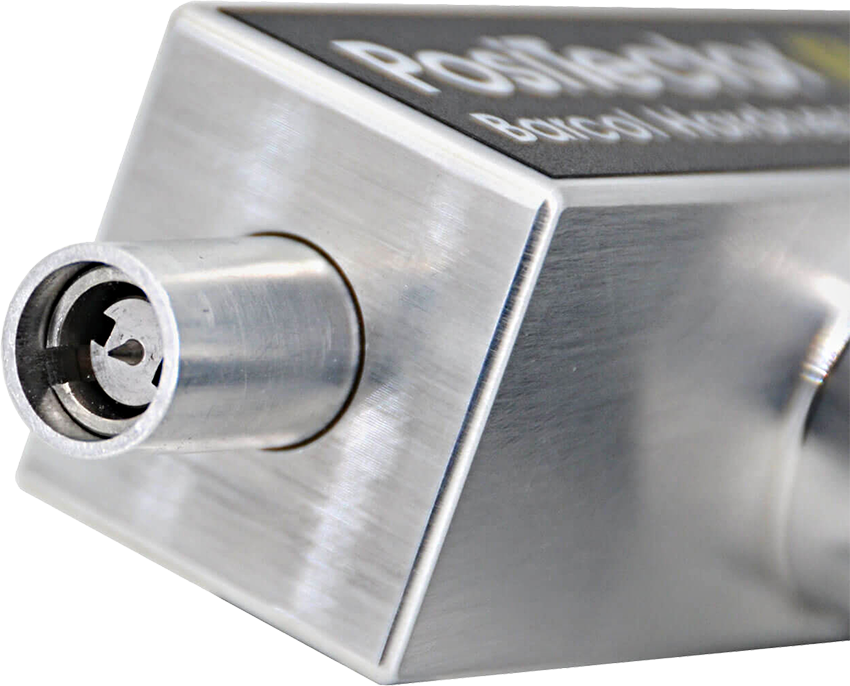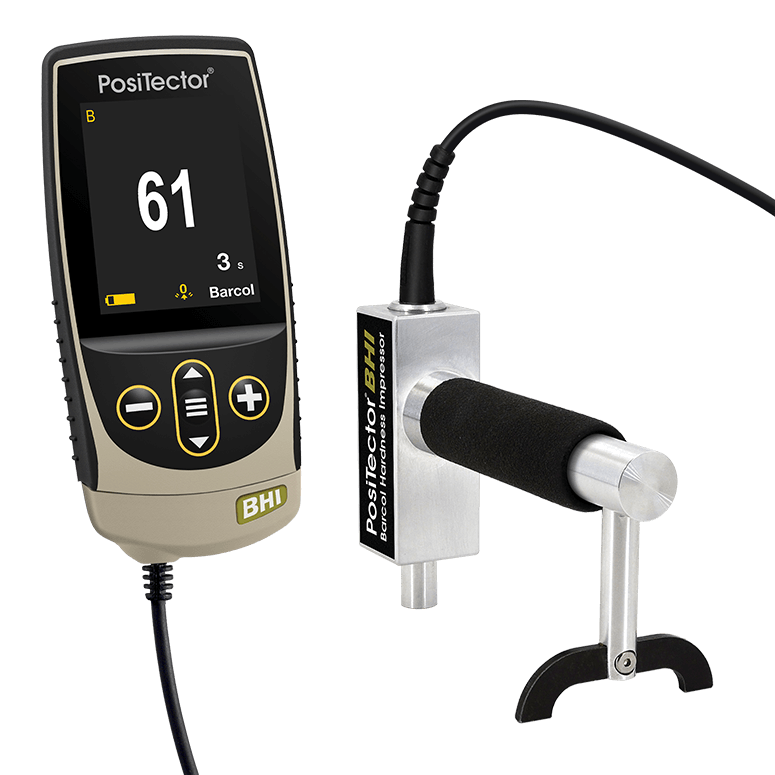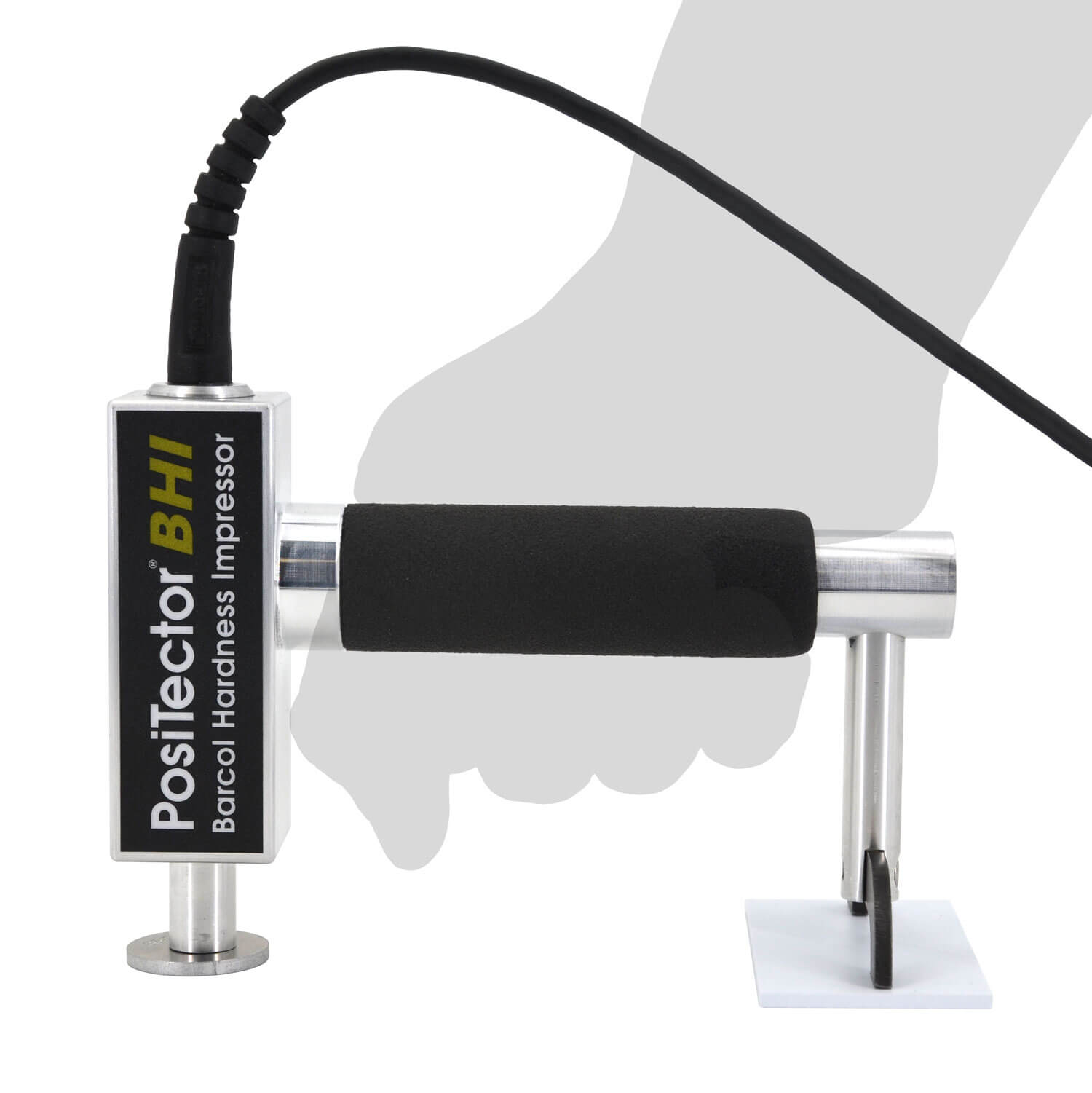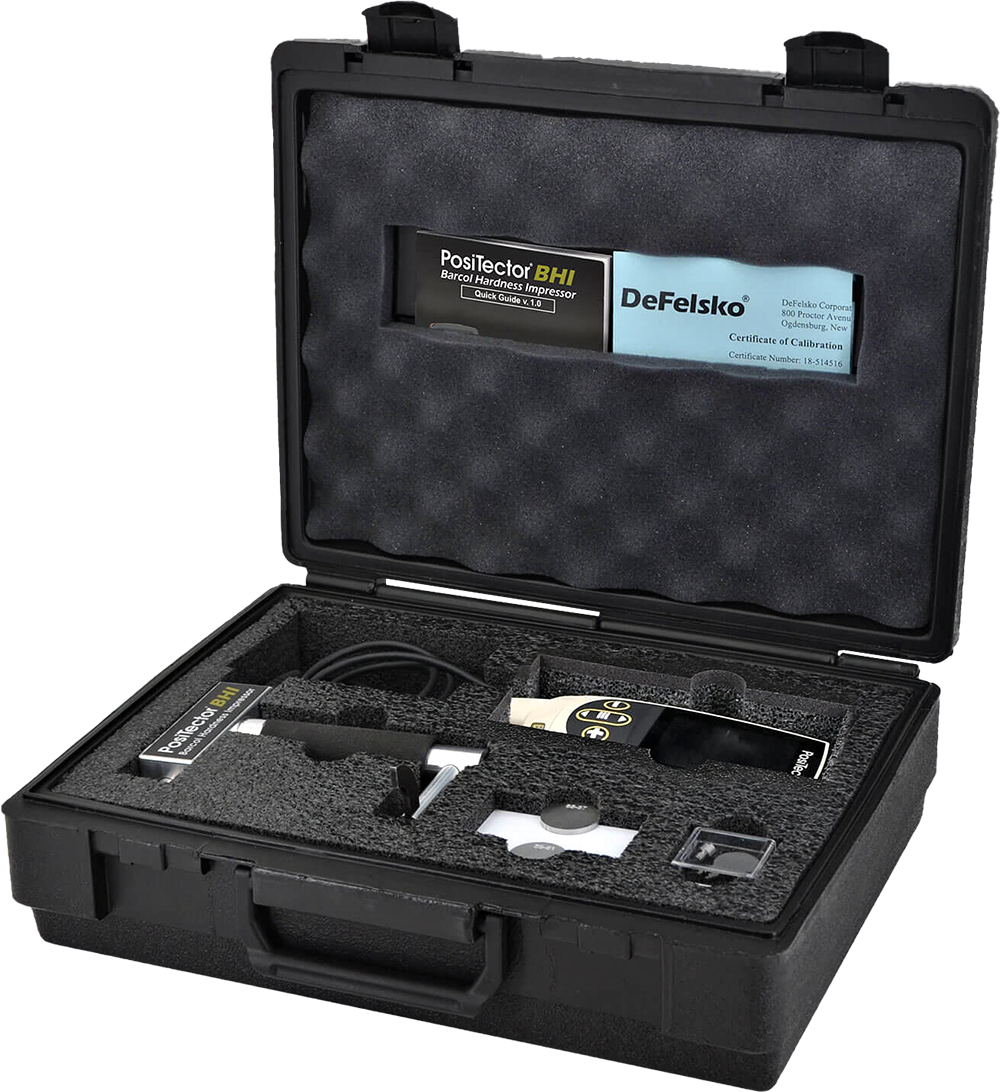Measures the hardness of soft metals such as aluminum, aluminum alloys, copper, brass, and other materials such as harder plastics, and fiber-reinforced plastic.



| DeFelsko PosiTector BHI Barcol Hardness Tester Technical Specifications | |
| Measurement Range: | 200 - 100 Barol |
| Resolution: | 0.1 Barcol |
| Accuracy: | ± 2 Barcol |
| Gauge Body Dimensions: | 5.4" x 2.4" x 1.1" (137 x 61 x 28 mm) |
| Gauge Body Weight: | 4.9 oz. (140 g) without batteries |
| Probe Size: | 5.7" x 3.8" x 2.5" (145 x 97 x 64 mm) |
| Probe Headroom: | 5.5" (140 mm) |
| Probe Weight: | 14.1 oz. (400 g) |


The PosiTector BHI Barcol Hardness Tester is designed for testing the hardness of rigid plastics and soft metals such as aluminum, aluminum alloys, copper, and brass. Comparable to 934-1 Barcol hardness Tester, the PosiTector BHI features an easy-to-read digital display, onboard memory, and includes a user-adjustable measurement timer with on-screen countdown.
For nearly 80 years, the Barcol Hardness test has been used to measure the hardness of materials. Conceived during World War II as a way to ensure aircraft rivets had not been sabotaged with inferior quality metal, the Barcol Hardness Impressor is still used today for a variety of applications including aluminum production, fiber and glass reinforced plastics, duro or hard thermo plastics, and to measure the degree of cure in composite materials.
Hardness is a measure of a material’s ability to resist permanent deformation such as bending, scratching, abrasion, or cutting. Quality Assurance and Quality Control demands require each material to meet a specific standard of hardness—often determined by tests like those done with a Barcol hardness tester.
Indentation hardness testers such as the PosiTector BHI Barcol Hardness Impressor use a precisely-shaped tip/indentor connected to a calibrated spring, and measure how far the tip penetrates into the material. The greater the indentation, the lower the hardness.
Barcol hardness is measured with a portable, hand-held unit like the PosiTector BHI, consisting of an indicating device (display) and an indentor. Per ASTM B648, “the indentor [is a] hardened steel truncated cone having an angle of 26° with a flat tip…”. One unit of Barcol hardness is equivalent to the indentor moving 0.0076 mm (0.00030 in.). A reading of zero means that the indentor penetrated the full 0.76 mm (0.03 in.) into the surface, without compressing the spring compress. A reading of 100 means that the indentor did not penetrate into the surface at all, and that the spring is fully compressed. A higher reading indicates a harder material.
At the beginning and the end of each work shift, check the accuracy of the meter with the included test disks and leveling plate. On a hard, flat surface, place the Barcol hardness tester’s legs on top of the leveling plate and the test disk under the indentor tip. Once the gage is positioned, press the PosiTector BHI firmly down. Observe the measurement on the easy-to-read digital display. Take 3-5 readings on each disk to verify accuracy, ensuring at least 3 mm (1⁄8 in.) of distance from previous impressions.
 What are the Benefits of using a digital PosiTector BHI Barcol Hardness Impressor?
What are the Benefits of using a digital PosiTector BHI Barcol Hardness Impressor?Digital Readout
The easy-to-read digital display takes the guess work out of reading analog scales, reducing the likelihood of operator error.
Memory, Statistics, and USB Port
Each digital reading is stored into memory for future review and reporting. The on-screen statistics display makes it easy to identify trends and average readings. When measurement is complete, use the built-in USB port to download readings to a PC or Mac.
Four Free Software Solutions
DeFelsko offers four free and unique ways to view, analyze, and report Barcol hardness data using PosiSoft Solutions. Select from a powerful desktop version, an easy-to-use mobile app, cloud storage, or PosiSoft USB – a simple gage interface similar to a flash drive. To learn more about our PosiSoft Solutions follow the link here.
Test Timer
The PosiTector BHI features an on-screen timer when measuring the hardness of a material. Set the timer to the desired limit, and it will automatically start counting down once the indentor is pressed firmly down on to the surface.
Continuous Readings
When enabled, the PosiTector BHI will continuously display hardness readings. Continuous Reading mode is ideal when a test timer is not required or when performing a calibration verification.
Statistics Mode
On-screen statistics like average, standard deviation, and min/max hardness are continually updated and displayed while measuring. All readings and statistics can be recorded into memory for further analysis and reporting.
HiLo Alarm
The HiLo Alarm on the PosiTector BHI allows the gage to audibly and visibly alert the user when the readings exceed user-specified limits.
Auto Sub-Batch
The Auto Sub-Batch automatically creates a new sub-batch in the Advanced model of the PosiTector BHI after the necessary number of readings are stored.
The following standards are used to determine the Barcol hardness of a material.
ASTM B648—Standard Test Method for Indentation Hardness of Aluminum Alloys by Means of a Barcol Impressor
ASTM B648 guides the user through measuring the hardness of aluminum alloys. It defines proper techniques and procedures for measuring aluminum.
“1.1 This test method covers the determination of indentation hardness of aluminum alloys using a Barcol Impressor…”
“5.2 The Indentor shall consist of a hardened steel truncated cone having an angle of 26 degrees with a flat tip 0.157 mm (0.0062in) in diameter.”
ASTM B648 Test Procedure with the PosiTector BHI:
1. Place the specimen on a flat, hard surface so as to not bend or deform the part being measured.
2. Firmly grasp the impressor and set the legs and point sleeve on the surface to be tested. Use the test stand if necessary to keep the point sleeve (or indentor) perpendicular to the object being measured.
3. Quickly apply sufficient pressure to ensure firm contact with the test specimen. Avoid sliding or scraping the probe as it will produce erroneous readings and may damage the probe tip. The reading will automatically be saved into the PosiTector Gauge’s memory.
*Refer to ASTM B648 for a complete description of the test standard.
ASTM D2583—Standard Test Method for Indentation Hardness of Rigid Plastics by Means of a Barcol Impressor
ASTM D583 standard test method determines the indentation hardness of both reinforced and non-reinforced rigid plastics using a Barcol Hardness Impressor.
“1.1 This test method covers the determination of indentation hardness of both reinforced and non-reinforced rigid plastics using a Barcol Impressor…”
“4.1 A material’s surface hardness is determined through the use of a Barcol Impressor. The relative depth of penetration of the Impressor’s indentor provides a comparative measure of the material’s hardness.”
ASTM D2583 Test Procedure:
1. Place the specimen on a flat, hard surface so as to not bend or deform the part being measured. A soft surface may produce a false, low reading.
2. Firmly grasp the impressor and set the legs and point sleeve on the surface to be tested. Use the test stand if necessary to keep the point sleeve (or indentor) perpendicular to the object being measured. Quickly apply sufficient downward pressure to ensure firm contact with the test specimen. Avoid sliding or scraping the probe as it will produce erroneous readings and may damage the probe tip. The reading will automatically be saved into the PosiTector Gauge’s memory.
*Refer to ASTM D2583 for a complete description of the test standard.

An easy-to-use mobile app (iOS/ Android) that connects to your PosiTector Advanced, PosiTector Smartlink, or PosiTest AT-A. Compatible with PosiSoft.net.

Powerful desktop software for downloading, archiving, and reporting measurement data. No internet connection required.
A simple gage interface to retrieve data in a manner similar to a flash drive. No software to install or internet connection required.
From wired USB to WiFi wireless technology, DeFelsko instruments offer data management solutions for even the most advanced software integrations. Accessing your stored or live streaming data is simpler and more flexible than ever before. PosiTector and PosiTest AT-A instruments have the ability to integrate with third-party software, drones, ROVs, PLCs, and robotic devices using several industry-standard communication protocols.

PosiTector body accepts all PosiTector 6000, 200, RTR, SPG, DPM, IRT, SST, UTG, SHD, BHI, and GLS probes easily converting from a coating thickness gage to a surface profile gage, dew point meter, soluble salt tester, ultrasonic wall thickness gage, hardness tester, or gloss meter.
The Advanced Model accepts the PosiTector DPM L in addition to the probes listed above.